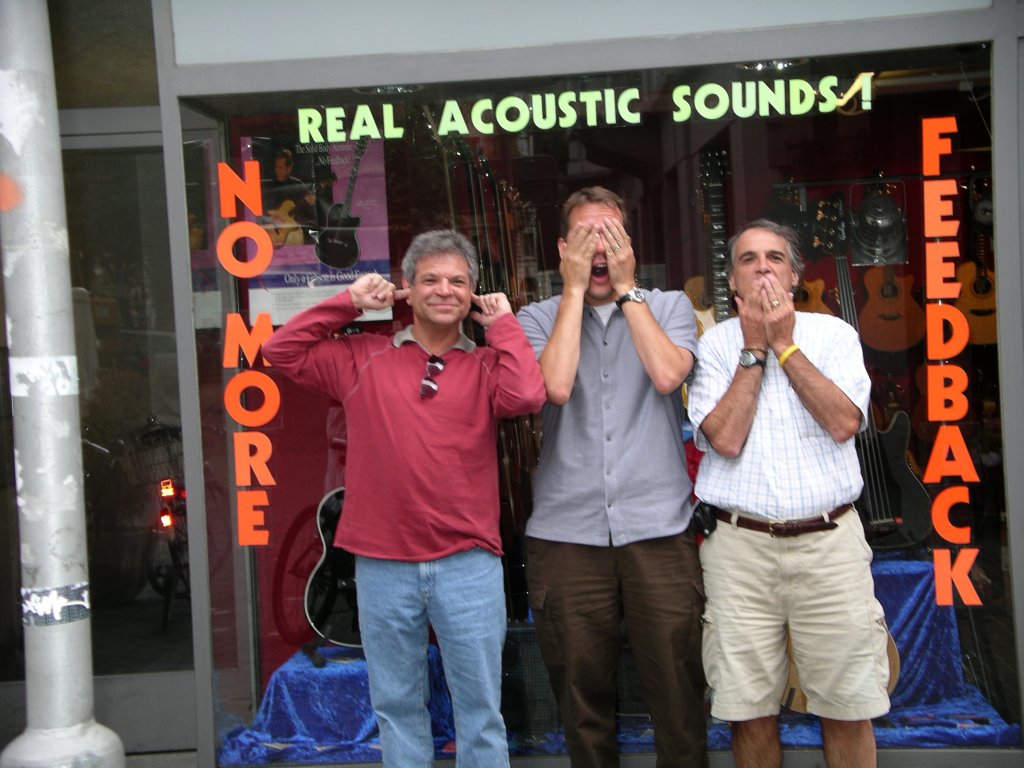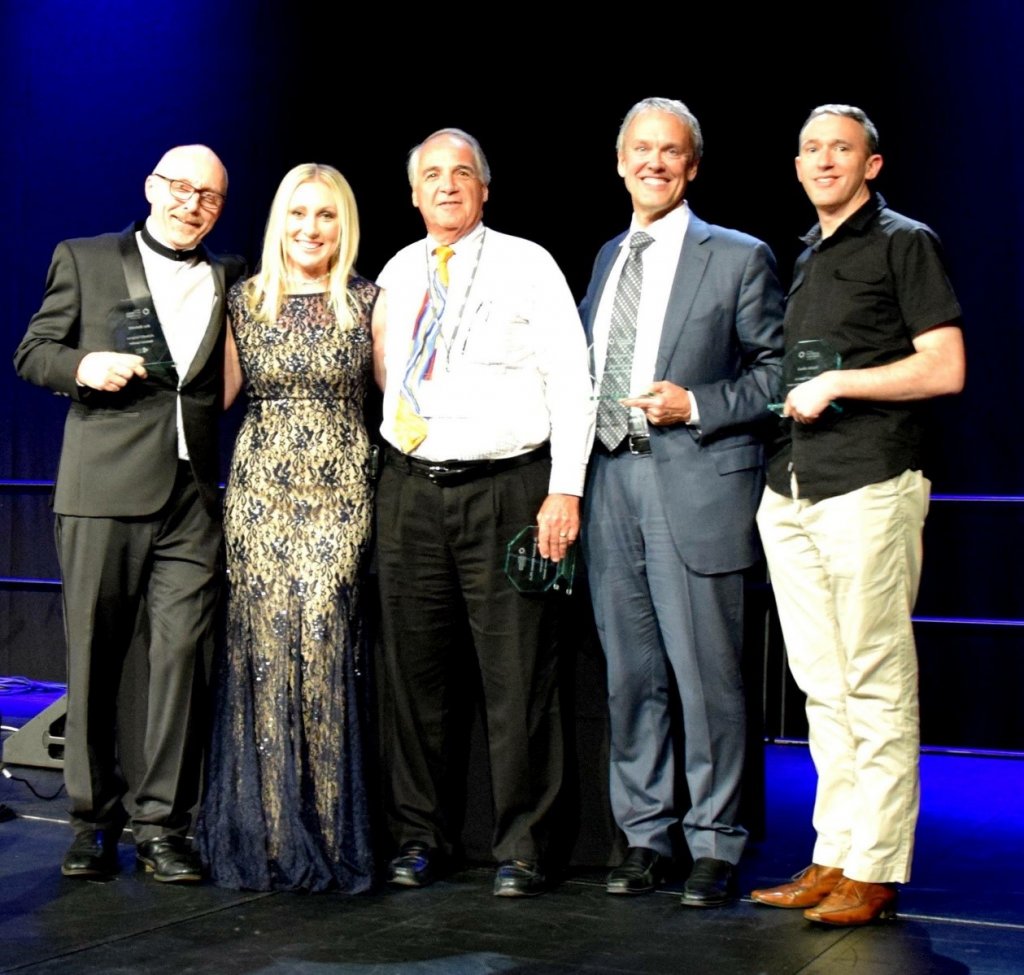Mike Valente: Colleague and Friend

Robert Sweetow, Dave Fabry, and Mike Valente.
I have had the distinct pleasure of working on many research projects with Dr. Mike Valente over the years, culminating in several publications. My experience in collaborating with Mike over nearly 25 years’ time is that he is unswervingly deadline-driven, clinically relevant, evidence-based, incredibly efficient, and “radically candid.” To wit: Mike invited me to contribute a chapter in his textbook, Hearing Aid Evaluation, published by Singular Press in 1994.1 At the time, I had just been made chief of audiology at the Mayo Clinic, and served as associate editor of amplification for Ear and Hearing. I had a two-year old daughter, a burgeoning clinical load and fledging research program, and fell behind on my commitment deadlines (a lifelong affliction). Everyone who has attempted to edit a multi-authored textbook knows that this is the nature of the beast, but Mike is the most effective “cat herder” I have ever worked with; he allows no excuses (seriously – who can argue that they are busier than him?) and he always finds a way to the solution while adhering to his timelines every time. It is a rare talent, and I admire him for it.
Another lesson that I have learned from Mike is to consistently focus on the needs of the patient, whether in the clinic or laboratory. This focus has served him – and the profession – extremely well over the years, and it has made it pleasure to partner with him. After the kerfuffle with the FDA in the US in the early 1990s over hearing aid noise-reduction claims, manufacturers were required to conduct multicentre studies if they wanted to make a claim regarding speech-in-noise benefits. Mike and I doubled up numerous times for early studies related to directional microphones2 and nonlinear amplification employed in digital hearing aids.3,4 More recently, I have relied on Mike many times in my role as an industry researcher, and he is the first person that I think of when I want to engage with a “key opinion leader” who will provide candid, honest feedback, and also conduct experiments by asking the right questions and following through with careful, deliberate data collection and interpretation. He “walks the talk” in a way that few others do, even when it is unpopular to do so.
Finally, I am forever indebted to Mike, as he was the first person to invite me as a conference speaker for a hearing aid meeting that he jointly organized with Margaret (Margot) Skinner in 1990 at Washington University/Central Institute for the Deaf. I had completed my dissertation in 1988, and was research audiologist at Walter Reed Army Medical Center. I was asked to give a presentation based, in part, on work that I had completed on developing realistic expectations from Mike the Zeta Noise Blocker and single-microphone noise-reduction systems. Other presenters at the conference included David Hawkins and Richard Seewald, and I was intimidated as hell to be on the same program with them. One of the highlights of the meeting was that I was invited to Margot’s house, along with Hawkins and Seewald, and we had a wonderful evening sharing stories and enjoying a meal prepared by Margot’s husband, Milton. A highlight of the evening was the “coin toss” to see who got the private guest room and who shared her sons Geoff and Jonathon’s room (Hawkins won the toss). It was the beginning of a tremendous privilege and opportunity that I have had to “travel the world on my ears” during the past three decades. Many of those trips have been in the same orbit as Mike: over the years, we have spoken at conferences on four or five continents, and I hope to have the opportunity to hit all seven before we are finished. Robert (the Thief) Sweetow stole my photo from Switzerland (my wife, Liz took the picture – see article by Robert Sweetow), so I attach a more recent photo from the ACAud conference in Adelaide, Australia in 2017. Even more recently, Mike participated in a Grand Rounds in Adult Audiology that I facilitated at the American Academy of Audiology’s 2018 annual meeting in Nashville, Tennessee. Mike presented results from a recently completed study where he challenged the conventional wisdom that use of real-ear measurements result in improved audibility but lower patient satisfaction by conducting a double-blind, randomized control design study that demonstrated improved performance AND preference in 19/24 subjects evaluated.5 He went on to challenge session attendees to adhere to best practice as the best antidote for the “disruptive” environment surrounding the distribution of hearing aids in the United States. I consider it an honour and privilege to have Mike as a colleague and friend, and I salute his sustained passion and dedication during a career focused on education, research, and clinical service.

Ian Mawby, Kylie Cicieri, Mike Valente, Dave Fabry, and Curtis Alcock in Australia.
References
- Fabry DA, and Schum D: Assessment of the Benefit of Subjective Rating Scales for Hearing Aid Fitting and Verification. In: M. Valente (ed) “Hearing Aid Evaluation,” Singular Press; 1994.
- Valente M, Fabry DA, Potts LG: Recognition of speech in noise with hearing aids using dual microphones. J Am Acad Audiol 1995;6:440–49, November.
- Valente M, Fabry DA, Potts LG, Sandlin RE: Comparing the performance of the Widex SENSO digital hearing aid with analog hearing aids. J Am Acad Audiol 1998;9:342–60.
- Valente M, Mispagel KM, Tchorz J, Fabry DA. Effect of type of noise and loudspeaker array on the performance of omnidirectional and directional microphones. J Am Acad Audiol 2006;17(6):398–412.
- Valente M. Does Programming to a Valid Prescriptive Target Yield A Better Outcome than First-Fit? Presentation at the Adult Grand Rounds Featured Session at the Annual Meeting of the American Academy of Audiology, Nashville, TN; 2018.

